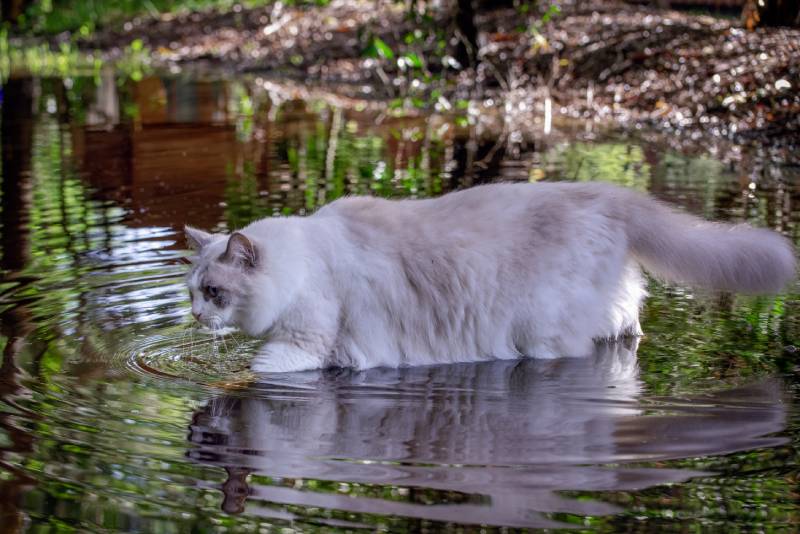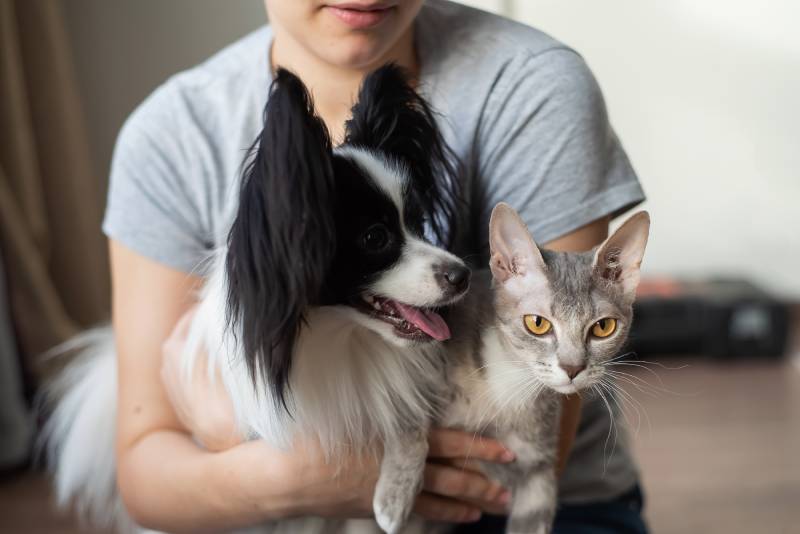Japanese Waving Lucky Cat: The History Behind Maneki-Neko
By Beth Crane
Updated on
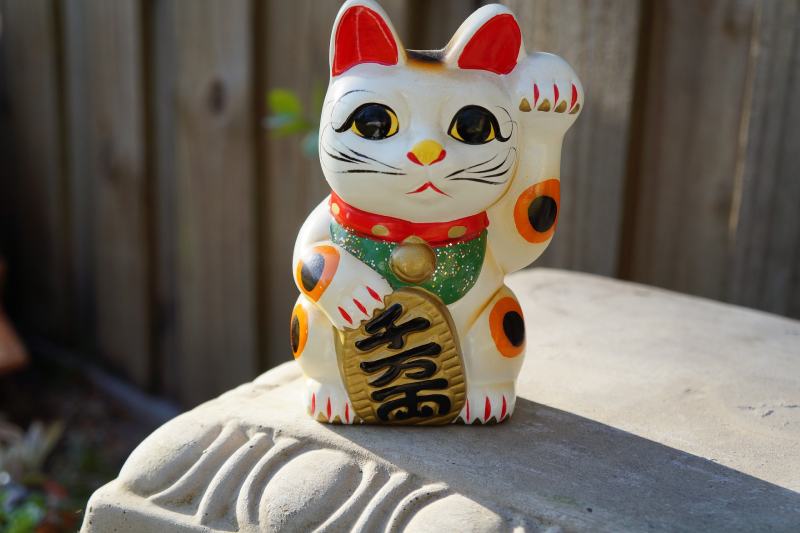
The Maneki-Neko has many names, including the beckoning cat, the welcoming cat, the money cat, lucky, and happy. All of these apply to this mysterious statue and its many forms. The Maneki-Neko is often found in the entrances of businesses all around Asia and in Asian businesses and communities worldwide, bringing good luck and fortune. But the brightly colored cat originated in Japan, with its origin in the 17th or 19th centuries.
Origins: The 17th Century or the 19th Century
Two origin stories grace the Maneki-Neko and point to the Edo period of Japan’s history. The Maneki-Neko was first brought to life sometime between 1603 and 1852, with the latter year producing the first recorded print reference to the lucky cat. However, the general consensus is that the Maneki-Neko was born in the 17th century in the Gotoku-Ji Temple.
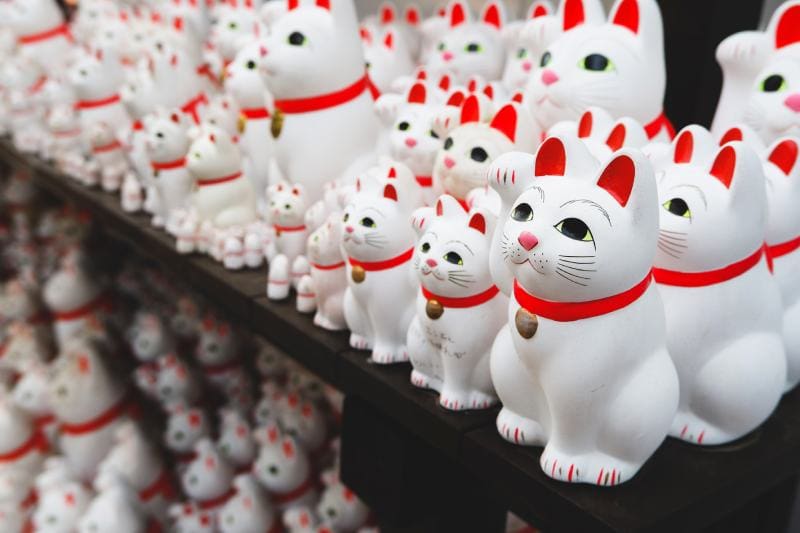
The 17th Century: Gotoku-Ji Temple
The first reference to the Maneki-Neko is from a story set in the Gotoku-Ji temple in Tokyo. A temple cat named Tama was a regular visitor to the shrines dotting the area and was present during a terrible rainstorm one evening. The Damiyo (the ruler of the region) or a Samurai (depending on who you ask) was outside under a tree sheltering from the rain when he noticed Tama beckoning him urgently into the temple. Naturally, the Damiyo obliged, but just as he cleared the tree, a lightning bolt struck the spot where he stood.
The little cat had saved his life. To honor Tama, the Damiyo erected his own shrine on the temple grounds as a patron of the Gotoku-Ji. Many worshippers left offerings at the shrine when they heard the tale, and this practice is still upheld today!
Today, tourists and worshippers can purchase statues of the Maneki-Neko Tama at the temple. Within its grounds, a Maneki-Neko is never far away.
The 19th Century: Imado Shrine
Jumping forward in time, another origin story of the cat that is no less amazing can be unearthed. The Imado Shrine in Tokyo upholds this legend from the former Imado township (now known as Asakusa). The story begins in 1852 with an older woman who lived in Imado with her beloved cat.
The woman was poor, and could no longer provide for her beloved friend, so she let the cat go. However, the legend says that that evening, the cat returned to her in a dream and promised her riches and fortune if she created statues in its image.
Shaken but resolute when she woke, the old woman obliged. She began to produce dolls of her precious cat from earthenware pottery and sold them at the shrine’s gates. The charming Maneki-Neko, sometimes portrayed as sitting sideways with its head facing forward, was an instant hit. The doll’s popularity grew, and the cat’s promise to its owner quickly came true.
The famed woodblock artist Hiroshige Utagawa produced a woodblock of a scene depicting the woman selling her Maneki-Neko at the shrine (or the Senso-Ji Temple) in the same year, further solidifying the cat into history. This is also the first recorded mention of the Maneki-Neko.
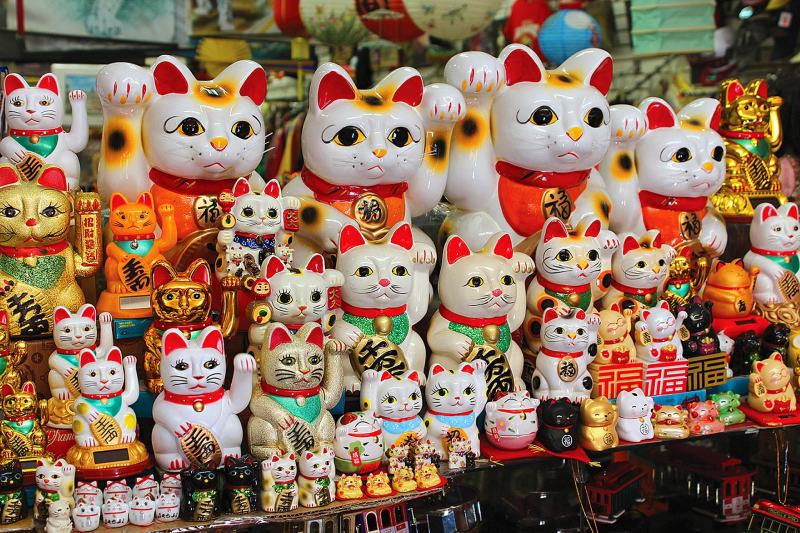
The 18th Century
Maneki-Neko figurines and depictions date back to the 18th century, with one being dated and displayed at the Brooklyn Museum. Because of this, it’s generally agreed that the Maneki-Neko originated in the 17th century. Many businesses in the 18th century sported the lucky cat’s image in their entryways, spreading it across Japan in the entry halls of eateries, shops, tea houses, and more.
However, the Maneki-Neko didn’t bloom into the worldwide symbol of austerity it is today until the late 19th and 20th centuries.
The 19th Century
This time period could explain how the lucky cat escaped the confines of Japan and spread its waving reach further into other Asian countries. During the Meiji period (1800–1912), the Japanese government banned phallic statues and other crude works that were common for the era, particularly those found at the entrance to brothels, as part of introducing new laws and penal codes. This was due partly to Western tourists’ influence on the public and new treaties formed between the US and Japan.
To replace these statues, institutions began to display Maneki-Neko statues outside and in the entryways of their establishments to attract luck and prosperity. This idea then spread into other communities and eventually reached other Asian countries.
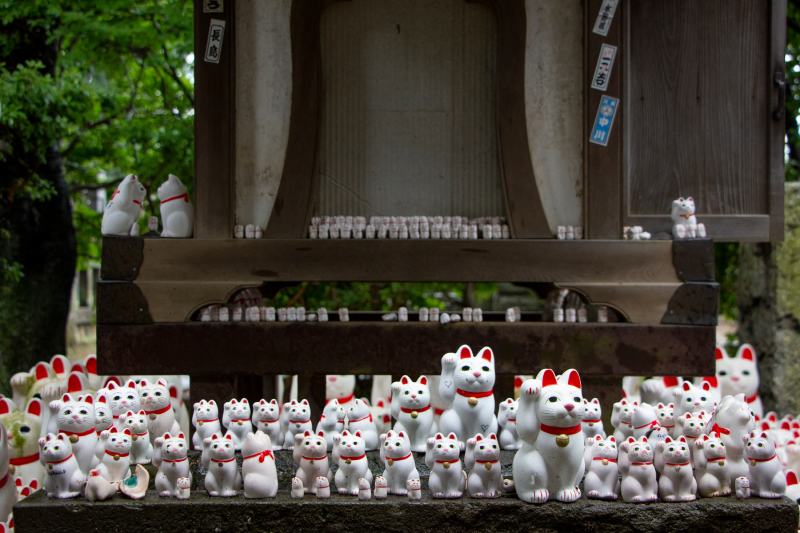
The 20th Century
True global appreciation for the Maneki-Neko occurred late in the 20th century, potentially when Japan had its “cool” phase in the 1980s/1990s. As a result, the country saw increased travel tourism, and its contribution to pop culture and video games became famous. The Maneki-Neko has its own place in the world’s new appreciation of Japan, with one character in the incredibly popular Pokemon franchise being a Maneki-Neko (Meowth).
 What Do the Colors of the Maneki-Neko Mean?
What Do the Colors of the Maneki-Neko Mean?
The Maneki-Neko is usually depicted as a calico Japanese Bobtail cat, but the waving feline has many variations in colors and patterns. Here are just some of the more popular colors and their meanings:
- White: Symbolizes positivity, purity, and luck
- Black: Symbolizes warding against evil and protection
- Gold: Symbolizes prosperity and wealth
- Red: Symbolizes love and marriage
- Pink: Symbolizes love and romantic love
- Blue: Symbolizes wisdom and success
- Green: Symbolizes good health
- Yellow: Symbolizes stability and good relationships
What Do the Different Items and Poses Mean?
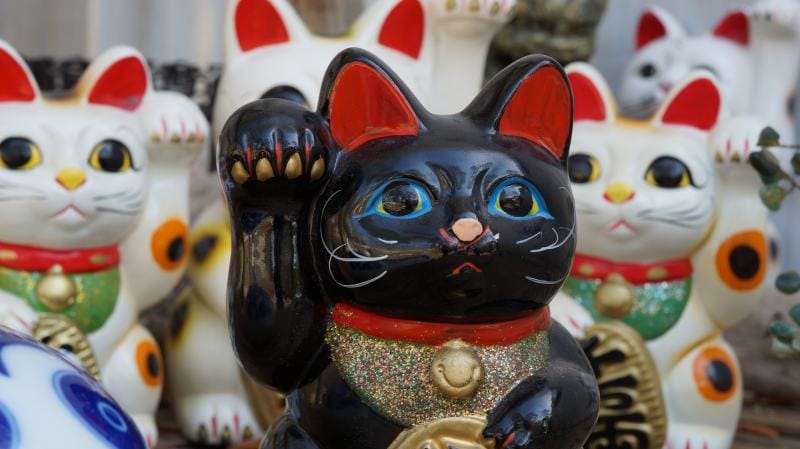
Just as the color of Maneki-Neko can mean different things, so too does the items it wears or holds. Items such as coins and gems are often seen included with the cat, and the cat’s paws can either both be up, or one or the other can be raised. These all have different meanings and can influence the magic that the Maneki-Neko holds:
Maneki-Neko Adornments
Some of the various adornments Maneki-Neko can be found with include:
- Coins: Maneki-Neko often holds gold coins known as “Koban,” used in the Edo period. These coins are worth one Ryo, which equates to around $1,000. Some Koban are even marked as being worth 10 million Ryo!
- Money bag: Money bags around the Maneki-Neko symbolize luck and wealth.
- Koi Carp: The images of Koi Carp around the Maneki-Neko represent fortune and abundance.
- Fan/Drum: Symbolizes luck in the business and the attraction of many customers.
- Gemstones: Said to bring wealth and wisdom.
- Collars with bells: Many Maneki-Neko will wear collars around their necks with bells. Japanese cats throughout history have worn collars with bells for the same reason modern cats do–so their owners can hear where they are!
Positioning of the Cat’s Paw
Which paw the Maneki-Neko is raising also has significance. If the left paw is raised, the Maneki-Neko is said to attract many customers (by waving them in). The Maneki-Neko is said to bring good luck and great fortune if the right paw is raised. If both paws are raised, the lucky cat projects and wards off all evil.
Why Is the Maneki-Neko Portrayed As Having a Waving Paw?
Maneki-Neko have waving paws because the little cat in the temple grounds, Tama, waved and beckoned the Damiyo in from the rain. Or, the waving could be taken from the Japanese signal for beckoning. The western gesture to beckon someone towards you is to wave your fingers in a “come here” movement with your palm facing up. In Japan, this is reversed, with the palm facing down while curling the fingers!
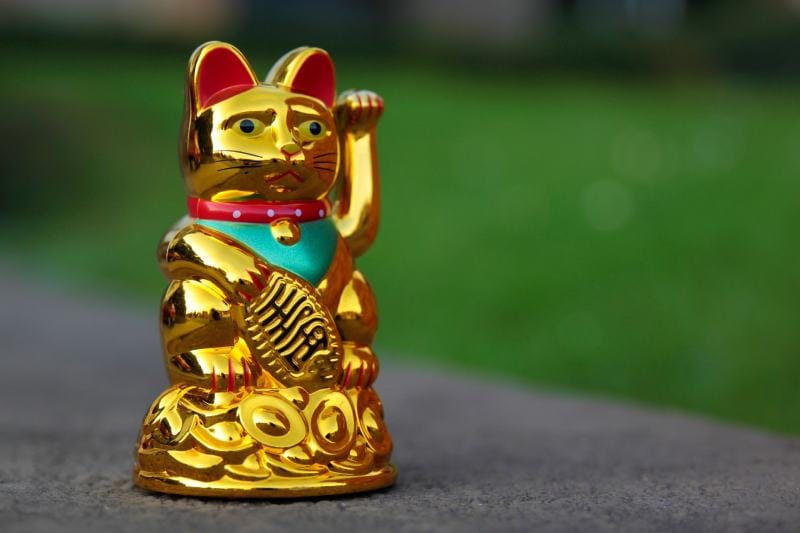
In Summary
Maneki-Neko has a special place in Japanese and broader Asian history and culture. The lucky cat is said to bring great fortune to many establishments, which is why you’ll commonly see it in the entryways of restaurants or shops in Asian communities worldwide. The history of the Maneki-Neko is murky, but most sources point to it originating from Tokyo in the 17th century.
See also:
Featured Image Credit:Carla Burke, Pixabay
 What Do the Colors of the Maneki-Neko Mean?
What Do the Colors of the Maneki-Neko Mean?